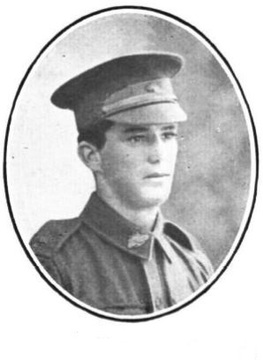Pte
Robert Alfred Wallace
Information about birth
|
Date of birth: 28/06/1892 |
|
Place of birth: Rockhampton, Queensland, Australia |
General information
|
Last known residence: Cheapside Street, Maryborough, Queensland, Australia |
|
Profession: Labourer |
|
Religion: Methodist |
Army information
|
Country: Australia |
|
Force: Australian Imperial Force |
|
Rank: Private |
|
Service number: 3892 |
|
Enlistment date: 16/08/1915 |
|
Enlistment place: Maryborough, Queensland, Australia |
Information about death
|
Date of death: 12/10/1917 |
|
Place of death: Dash Crossing, Broodseinde, Belgium |
|
Cause of death: Killed in action (K.I.A.) |
|
Age: 25 |
Cemetery
|
Tyne Cot Cemetery Plot: III. Row: A. Grave: 16. |
Distinctions and medals 3
|
1914-15 Star Medal |
|
British War Medal Medal |
|
Victory Medal Medal |
Points of interest 3
| #1 | Place of birth | ||
| #2 | Enlistment place | ||
| #3 | Place of death (approximate) |
My story
Robert Alfred Wallace was born July 28, 1892, in Rockhampton, the son of Robert Alfred Renforth Wallace and Eliza Payne Wallace. On August 16 1915, he entered military service.
Initially he was assigned to the 15th Bn. but on March 9, 1916, he was transferred to another unit. This was the 47th Bn. Australian Infantry, part of the 12th Australian Brigade, 4th Australian Division. On June 9, 1916, he arrived in France. In Western Europe, he was hospitalized twice for treatment of trench foot. This was a common occurrence as soldiers' feet were exposed to cold and rain for long periods of time.
On Oct. 12, 1917, the 4th Australian Division took part in the First Battle of Passchendaele, part of the Third Battle of Ypres that had been in progress since July 31, 1917. The objective of the 4th Australian Division was to advance over the Broodseinde Ridge to Keiberg Spur to flank the 3rd Division which was advancing north of the railroad towards Passchendaele. The 47th Battalion was given the task of capturing and holding the red line. This ran roughly from the railroad embankment to Assyria. Then the 48th Battalion would continue the attack.
The attack faced immediate setbacks. The soldiers were tired from marching through the mud. The battalion headquarters, located in a bunker on the Broodseinde ridge, was hit by German artillery shells. Almost all the signalmen and couriers were casualties, Robert was one of them.
The Germans retreated, but once the 48th Battalion advanced they faced heavy German fire from Vienna Cottage. This was in the 3rd Division's sector, but heavy resistance had prevented them from advancing. The German position at Vienna Cottage was eliminated, but finally, for lack of support, 47th and 48th Battalions had to retreat to their starting positions. Both battalions lost a total of nearly 1,000 soldiers.
Robert Alfred Wallace was temporarily buried close to the headquarters, between Dash Crossing and Defy Crossing, near the railroad embankment. He currently rests in Tyne Cot Cemetery. He was 25 years old.
Initially he was assigned to the 15th Bn. but on March 9, 1916, he was transferred to another unit. This was the 47th Bn. Australian Infantry, part of the 12th Australian Brigade, 4th Australian Division. On June 9, 1916, he arrived in France. In Western Europe, he was hospitalized twice for treatment of trench foot. This was a common occurrence as soldiers' feet were exposed to cold and rain for long periods of time.
On Oct. 12, 1917, the 4th Australian Division took part in the First Battle of Passchendaele, part of the Third Battle of Ypres that had been in progress since July 31, 1917. The objective of the 4th Australian Division was to advance over the Broodseinde Ridge to Keiberg Spur to flank the 3rd Division which was advancing north of the railroad towards Passchendaele. The 47th Battalion was given the task of capturing and holding the red line. This ran roughly from the railroad embankment to Assyria. Then the 48th Battalion would continue the attack.
The attack faced immediate setbacks. The soldiers were tired from marching through the mud. The battalion headquarters, located in a bunker on the Broodseinde ridge, was hit by German artillery shells. Almost all the signalmen and couriers were casualties, Robert was one of them.
The Germans retreated, but once the 48th Battalion advanced they faced heavy German fire from Vienna Cottage. This was in the 3rd Division's sector, but heavy resistance had prevented them from advancing. The German position at Vienna Cottage was eliminated, but finally, for lack of support, 47th and 48th Battalions had to retreat to their starting positions. Both battalions lost a total of nearly 1,000 soldiers.
Robert Alfred Wallace was temporarily buried close to the headquarters, between Dash Crossing and Defy Crossing, near the railroad embankment. He currently rests in Tyne Cot Cemetery. He was 25 years old.
Sources 5
|
(2016). Portrait of R.A. Wallace. John Oxley Library, State Library of Queensland https://trove.nla.gov.au/ Sources used |
|
Australia, Birth Index, 1788-1922 (eresource). http://www.library.gov.au Sources used |
|
Deayton Craig , Battle Scarred: the 47th Battalion in the First World War (Newport Big Sky publishing Ltd, 2011).156-188. Sources used |
|
First Australian Imperial Force Personnel Dossiers, 1914-1920 (National Archives of Australia, Canberra (NAA), B2455, Wallace, Robert Alfred). https://recordsearch.naa.gov.au/ Sources used |
|
McCarthy, Chris. Passchendaele: The Day by Day Account (Londen: Arms & Armour Press, 2018), 129-132 Sources used |
More information 4
|
Namenlijst (In Flanders Fields Museum) https://namenlijst.org/publicsearch/#/person/_id=8f289312-db2c-44bb-8b18-52118732d8cf |
|
Commonwealth War Graves Commission Database https://www.cwgc.org/find-records/find-war-dead/casualty-details/465027 |
|
Lives of the First World War (Imperial War Museum) https://livesofthefirstworldwar.iwm.org.uk/lifestory/7622108 |
|
The AIF Project (UNSW Canberra) https://aif.adfa.edu.au/showPerson?pid=311835 |
